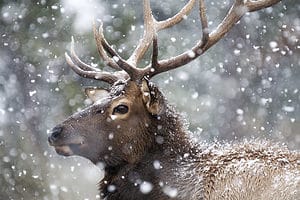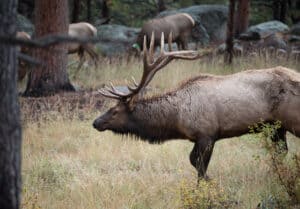Elk are some of the largest members of the deer family across the world. Seeing one is really the only way to experience their majesty! The United States features several species of elk, all of which have been hunted, scored, and kept as trophies to show off their sizes. Today, we are going to discover the largest elk ever caught in California, plus a little bit about why California elk are different than the other elk in the US. Let’s put on our hunting gear and dive into it!
The Largest Elk Ever Caught in California

A tule elk with a score of 379 is the largest elk ever measured in California.
©RelentlessImages/Shutterstock.com
The largest elk ever caught in California was a subspecies of elk known as a tule elk, with a score of 379, beating the previous record by a whopping 14 inches.
California is home to a unique subspecies of elk known as the tule elk. These elk are smaller and lighter than their Rocky Mountain cousins, but they can still grow impressive antlers. The largest tule elk ever recorded was not shot by a hunter but found dead on a ranch in Glenn County in 2005. The owner of the ranch, Jeff Lopeteguy, had the rack measured and landed the title from Boone & Crockett as the Tule Elk World Record with a score of 379.
The finding of the elk was a bit lucky! For years, the Lopeteguy family had seen a massive bull elk that was part of a herd on their property, but the family was content to allow the animal to roam without trying to hunt it. A few years later, however, a state wildlife agency found the bull on their property. When the agency found the antlers of the bull, they thought that it might be a record and brought it to Jeff Lopeteguy since it was on his land. Lopeteguy then had the rack measured. The result broke the record listed in the Boone & Crockett books.
What is a Tule Elk?

Tule elk are the only species of elk that exclusively live in Califonia, but they faced near extinction in the 1870s.
©Lu Yang/Shutterstock.com
A tule elk is a subspecies of elk native only to California. Its name comes from the tule, a type of grass that grows in the marshes where the elk often feed. Tule elk are the smallest of all elk species in North America, with adult males weighing between 450 and 700 pounds and females weighing between 375 and 425 pounds. They have beige coats with dark brown manes, with the classic white rumps that elk always have. Males have antlers that they shed and regrow every year.
Tule elk were once abundant and widespread in California, with an estimated population of 500,000 in the early 1800s. However, uncontrolled hunting and habitat loss by ranching and farming almost wiped them out by the 1870s. By then, only a single breeding pair survived in a marsh near Buena Vista Lake, thanks to the protection of a rancher named Henry Miller. In 1873, the state passed a law for the protection of the tule elk, and their numbers slowly recovered. In the 1970s, conservation efforts began for relocations of tule elk to different parts of the state, where they are starting to recover.
Today, there are over 5,000 tule elk in California. The government considers them vulnerable and they face threats that could still seriously threaten their population. Tule elk are an important part of the state’s natural heritage and need continued management and monitoring to help ensure their stability and survival.
Understanding Elk Trophy Scoring
The Boone & Crockett scoring is a way to measure how big and how even the antlers of an elk are. To get a score, follow these steps:
- You measure the points, beams, spread, and circumferences of the antlers with a tape measure and write them down on a chart.
- You add up all the measurements to get a total score in inches.
- You subtract the differences between the right and left antlers if they are normal or add the extra points if they are abnormal.
- You compare your score to the minimum scores for each elk type to see if it is big enough to go in a book of records.
For elk, the larger the score, the better. For the largest elk caught in California, the record set of antlers found on the ranch scored around 14 inches larger than the previous record, a pretty substantial jump when it comes to elk scoring.
The photo featured at the top of this post is © RelentlessImages/Shutterstock.com
Thank you for reading! Have some feedback for us? Contact the AZ Animals editorial team.







